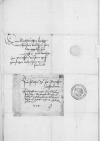Wir wissen E(wr) Ir(barkei)t nicht zwbergen, / das wir von unserm underthan, / meister Simon, painter in Löbau ⌊SimonnSimon, painter in Löbau ⌋, maler zwr Löbau (Lubawa, Lubavia), town in northern Poland, Kulm Land (Ziemia Chełmińska), ca. 67 km E of Graudenz (Grudziądz), the main seat of the bishops of Kulm (Chełmno)⌊LobawLöbau (Lubawa, Lubavia), town in northern Poland, Kulm Land (Ziemia Chełmińska), ca. 67 km E of Graudenz (Grudziądz), the main seat of the bishops of Kulm (Chełmno)⌋, / mit undertheniger bitt ersucht sein, / im in seinen anligenden sachen ein vorschrifft an E(wr) Ir(barkei)t zwgeben. / Derhalben ist an E(wr) Ir(barkei)t unser fruntlich bitt, / wolt im inn seinen sachen, / wie in beÿgelegter uns uberreichten supplication vormeldeth, / gnediglich erscheinen / und befhelenn, / das er sein geld, / so er seinem stiffsone zwgut / vor das gut Rapaty (Rappaten, Rapten), village in Ducal Prussia, Osterode (Ostróda) district, 7 km SW of Dietrichswalde (Gietrzwałd)⌊RaptenRapaty (Rappaten, Rapten), village in Ducal Prussia, Osterode (Ostróda) district, 7 km SW of Dietrichswalde (Gietrzwałd)⌋ gegeben, / wider uberkom(m)en magk, / dan es ist landtkundig und offenbar, / das / das gut von des erben vater umb hundert und czwenczigk m(a)rgk, / wie ms. wir(!)
⌈wiewie ms. wir(!)
⌉ dan in der supplication vormeldet wirt, / vorpfandt ist gewest, / und das es unser underthan, der moler, / dem stiff sone zwgut gelost hot etc. Beschulden wir widerumb E(wr) Ir(barkei)t, die wir Gote dem almechtigen in langkweriger gelugseliger regirung thun befhelen, / in solchem und grossern alczeit gerne. /
 GStA, PK, HBA, C 2, No 79, f. 5v
GStA, PK, HBA, C 2, No 79, f. 5v  GStA, PK, HBA, C 2, No 79, f. 1r
GStA, PK, HBA, C 2, No 79, f. 1r 
